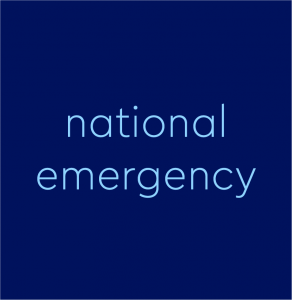Politics dictionary
national emergency
[ nash-uh-nl ih-mur-juhn-see ]
What is a national emergency?
In the United States, the term national emergency involves to a situation in which the president exercises their emergency powers. Governors and mayors declare states of emergency in response to disasters (e.g., after hurricanes) or other dangers, authorizing them to secure and mobilize needed resources.
The phrase national emergency is often used generally to refer to an urgent crisis (e.g., poverty, violence) that is affecting an entire country regardless of whether an official emergency has been declared or not.
Legally, there is no official definition of the term national emergency. Despite being named after it, even the National Emergencies Act of 1976 does not provide a definition of national emergency. Instead, the term has been used generally to refer to a situation where the president is exercising their emergency powers.
Since 1976, there have been 58 national emergences declared by US presidents. As of 2020, 31 of them are still ongoing.
To give some examples of past national emergencies prior to the COVID-19 pandemic, Jimmy Carter proclaimed a national emergency in 1979 in response to the Iran hostage crisis, Bill Clinton called a national emergency in 1996 after American civilian planes were shot down near Cuba, George W. Bush declared a national emergency in 2001 in response to the September 11 terrorist attacks, Barack Obama declared a national emergency in 2010 in the face of threats posed by Somali pirates, and Donald Trump declared a national emergency in 2017 in reaction to the Rohingya crisis in Myanmar.
Where does national emergency come from?

In terms of official declarations, President Franklin D. Roosevelt was the first to use the term national emergency in a proclamation he made on September 8, 1939 declaring the neutrality of America during the outbreak of World War II. However, President Woodrow Wilson in 1917 cited the term national emergency as it had been used in a 1916 act of legislation that gave the president the power to restrict the transportation of ships. Arguably, the concept of the president gaining emergency powers during a national emergency could go back to President Abraham Lincoln suspending habeas corpus during the Civil War.
As mentioned previously, there is no one, single legal definition of national emergency. Instead, Congress has used this phrase in legislation that gives the president extra powers during certain circumstances. All told, the president has around 120 different powers given to them during a national emergency. These emergency powers range from adjusting the pay of soldiers) to abilities to circumvent regulations or constraints (such as deploying soldiers without approval from Congress and possibly allowing the president to take control of the entire Internet during wartime).
Congress attempted to curb presidential emergency powers with the enactment of the National Emergencies Act of 1976. While the act doesn’t actually give an official government definition of national emergency, it is the closest that federal legislation comes to clarifying the term:
“In the event the President finds that the proclamation of a national emergency is essential to the preservation, protection, and defense of the Constitution, and is essential to the common defense, safety, or well-being of the territory and people of the United States, the President is authorized to proclaim the existence of a national emergency.”
Presidents have taken advantage of the vagueness surrounding the idea of a national emergency to enact executive orders that seemingly work around Congress and constraints on their executive power.
For example, Franklin Roosevelt cited a national emergency when he ordered the internment of Japanese-Americans during World War II and President George W. Bush declared a national emergency following the September 11 terrorist attacks that greatly enhanced the executive branch’s ability to perform surveillance. In modern times, President Donald Trump declared multiple national emergencies in response to the COVID-19 pandemic and the threat of … TikTok.
Examples of national emergency
Who uses national emergency?
The legal ambiguity of the term national emergency is often a source of debate about how much power the president should really have and what even qualifies as a national emergency. Presidents are usually said to declare national emergencies, though other such verbs as proclaim and issue are used; a national state of emergency and nationwide emergency are also sometimes used as terms for national emergencies.
I'm glad that the House stepped up to defend the Constitution and stop President Trump's unprecedented overreach by voting to block his national emergency declaration.
— Jim Cooper (@repjimcooper) February 27, 2019
Trump to Pelosi/Schumer: If we got $5 billion, we could do a tremendous chunk of wall..this is a national emergency
— Chad Pergram (@ChadPergram) December 11, 2018
Pres Obama extends National Emergency on Iran for another year. In place since hostage crisis of 1979. Allows for US sanctions to continue.
— Mark Knoller (@markknoller) November 10, 2015
The phrase “national emergency” is also often used generically to refer to widespread problems that affect all Americans such as climate change, poverty, racism, unequal access to healthcare, and gun violence.
So Tik Tok is a national emergency but racism isn’t, got it.
— Bella Langlois (@bellaylanglois) August 8, 2020
A few issues that warrant a national emergency:
🚩Climate Change
🚩Student Debt
🚩Income Inequality
🚩Crumbling Infrastructure
🚩@realDonaldTrump— Will Haskell (@WillHaskellCT) February 15, 2019
Poverty is a national emergency.
Wealth inequity is a national emergency.
Drug crisis is a national emergency.
Climate change is a national emergency.
Gun violence is a national emergency.
Healthcare is a national emergency.— W. S. Fletcher (@WoodySFletcher) February 15, 2019
Note
This is not meant to be a formal definition of national emergency like most terms we define on Dictionary.com, but is rather an informal word summary that hopefully touches upon the key aspects of the meaning and usage of national emergency that will help our users expand their word mastery.